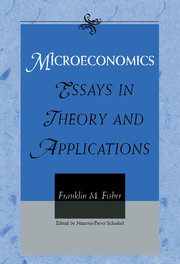Book contents
- Frontmatter
- Contents
- Introduction
- Part I Disequilibrium and Stability
- 1 The Formation of Economic Magnitudes: Disequilibrium and Stability (1990)
- 2 Quasi-Competitive Price Adjustment by Individual Firms: A Preliminary Paper (1970)
- 3 Stability and Competitive Equilibrium in Two Models of Search and Individual Price Adjustment (1973)
- 4 On Price Adjustment without an Auctioneer (1972)
- 5 Quantity Constraints, Spillovers, and the Hahn Process (1978)
- 6 On Stability Analysis with Disequilibrium Awareness (1988)
- 7 It Takes t* to Tango: Trading Coalitions with Fixed Prices (1989)
- 8 An Alternate Proof and Extension of Solow's Theorem on Nonnegative Square Matrices (1962)
- 9 Choice of Units, Column Sums, and Stability in Linear Dynamic Systems with Nonnegative Square Matrices (1965)
- 10 A Simple Proof of the Fisher–Fuller Theorem (1972)
- 11 Gross Substitutes and the Utility Function (1972)
- Part II Welfare Economics and Consumer Theory
- Part III Applications of Microeconomic Theory
- Part IV Industrial Organization, Economics, and the Law
- Part V Public Policy Applications
- Epilogue
- Indexes
1 - The Formation of Economic Magnitudes: Disequilibrium and Stability (1990)
Published online by Cambridge University Press: 20 March 2010
- Frontmatter
- Contents
- Introduction
- Part I Disequilibrium and Stability
- 1 The Formation of Economic Magnitudes: Disequilibrium and Stability (1990)
- 2 Quasi-Competitive Price Adjustment by Individual Firms: A Preliminary Paper (1970)
- 3 Stability and Competitive Equilibrium in Two Models of Search and Individual Price Adjustment (1973)
- 4 On Price Adjustment without an Auctioneer (1972)
- 5 Quantity Constraints, Spillovers, and the Hahn Process (1978)
- 6 On Stability Analysis with Disequilibrium Awareness (1988)
- 7 It Takes t* to Tango: Trading Coalitions with Fixed Prices (1989)
- 8 An Alternate Proof and Extension of Solow's Theorem on Nonnegative Square Matrices (1962)
- 9 Choice of Units, Column Sums, and Stability in Linear Dynamic Systems with Nonnegative Square Matrices (1965)
- 10 A Simple Proof of the Fisher–Fuller Theorem (1972)
- 11 Gross Substitutes and the Utility Function (1972)
- Part II Welfare Economics and Consumer Theory
- Part III Applications of Microeconomic Theory
- Part IV Industrial Organization, Economics, and the Law
- Part V Public Policy Applications
- Epilogue
- Indexes
Summary
Introduction
The title of this Conference is “The Formation of Economic Magnitudes.” Yet, if the papers prepared for it are true to the course of modern economic theory, most of them will, in a very real sense, not concern that subject at all. Modern economic theory is overwhelmingly a theory of equilibrium. It analyzes positions from which there is no incentive to depart, positions at which the plans and expectations of economic agents are mutually compatible. It is almost silent on the question of how such positions get reached, on how economic magnitudes get formed if they do not happen already to be in equilibrium.
Equilibrium analysis is an elegant and powerful tool, providing considerable illumination of the way in which real economies operate. But the total concentration on equilibrium now characteristic of formal economic models runs the serious risk of misunderstanding the basic insights of economics itself. Thus, the proposition that competitive industries earn no profits in long-run equilibrium is an important (if elementary) theorem. To take this to mean that competitive industries never earn profits is not only wrong, it is to lose sight of the fundamental role that profits and losses play in the allocation of resources when demand or technology changes. The proposition that competitive equilibria and Pareto-optima are closely related is a basic insight. The policy prescription that (under the conditions of the two Welfare Theorems) government interference with a competitive system is bound to be inefficient requires more than this, however; it requires the assurance that competitive economies are close to equilibrium most of the time.
- Type
- Chapter
- Information
- MicroeconomicsEssays in Theory and Applications, pp. 25 - 50Publisher: Cambridge University PressPrint publication year: 1999



